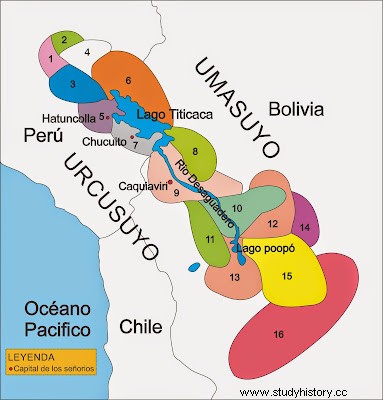 Location of the main Aymara peoples HISTORY Like most pre-Hispanic societies of this period, there is more ethnohistoric information than archaeological information, hence there is a tendency towards limiting generalization in the description of pre-Hispanic Andean societies. However, the Collas and the Lupaqas have somehow been the subject of interdisciplinary studies. Hatunqolla –intensely investigated by C. Julien– was the main seat of the Collas, or perhaps their capital, as some researchers suggest, and Chucuito that of the Lupaqas. Very close to Hatunqolla is Sillustani, a site characterized by the most successful chullpas or funerary constructions, with a circular or quadrangular floor plan, built like towers. Hatunqolla and Chucuito would have been at the same time nuclei that headed other smaller centers built with fortifications inside and outside the altiplano basin. During the Late Intermediate Period, the altiplano region was densely populated by small ethnic groups represented by political entities of a certain complexity, known as as “lacustrine kingdoms” or “kingdoms and Aymara manors”. These entities were later incorporated by the Incas. In reality, it is a region, perhaps the only one, where ethnic heterogeneity is quite large, although Collas, Lupaqas and Pacajes are recognized as the most important ethnic groups located around Lake Titicaca, in the territory called Urcusuyu. The eastern side was called Umasuyu. Other groups occupied territories from Canchis and Canas in the north to Potosí in the south, although these ethnic representations could be the result of the later Inka ordering of the region. The linguistic predominance in the region of the Aymara and Puquina languages deserves to be highlighted. The Aymaras would be the ancient Tiwanakus of the Middle Horizon.
Location of the main Aymara peoples HISTORY Like most pre-Hispanic societies of this period, there is more ethnohistoric information than archaeological information, hence there is a tendency towards limiting generalization in the description of pre-Hispanic Andean societies. However, the Collas and the Lupaqas have somehow been the subject of interdisciplinary studies. Hatunqolla –intensely investigated by C. Julien– was the main seat of the Collas, or perhaps their capital, as some researchers suggest, and Chucuito that of the Lupaqas. Very close to Hatunqolla is Sillustani, a site characterized by the most successful chullpas or funerary constructions, with a circular or quadrangular floor plan, built like towers. Hatunqolla and Chucuito would have been at the same time nuclei that headed other smaller centers built with fortifications inside and outside the altiplano basin. During the Late Intermediate Period, the altiplano region was densely populated by small ethnic groups represented by political entities of a certain complexity, known as as “lacustrine kingdoms” or “kingdoms and Aymara manors”. These entities were later incorporated by the Incas. In reality, it is a region, perhaps the only one, where ethnic heterogeneity is quite large, although Collas, Lupaqas and Pacajes are recognized as the most important ethnic groups located around Lake Titicaca, in the territory called Urcusuyu. The eastern side was called Umasuyu. Other groups occupied territories from Canchis and Canas in the north to Potosí in the south, although these ethnic representations could be the result of the later Inka ordering of the region. The linguistic predominance in the region of the Aymara and Puquina languages deserves to be highlighted. The Aymaras would be the ancient Tiwanakus of the Middle Horizon.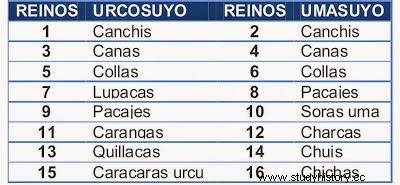
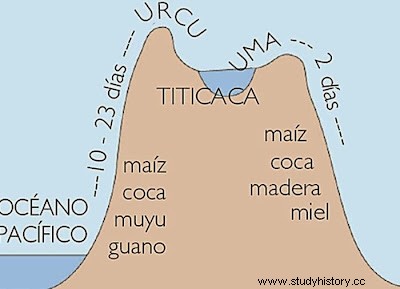 Control of ecological floors LANGUAGE The majority language in the highlands of Collao was Aymara or Haque aru. The Aymara language is one of the oldest in the American continent and in the case of Peru, it is the one that constitutes its linguistic stratum primer. It is an agrarian language that reveals that the people it speaks of have been and are a farming and ranching people due to its numerous terms referring to the cultivation of farms and the herding of flocks." The Aymara language, due to the lack of writing in yes, it has been transmitted spontaneously from generation to generation for millennia, exclusively orally, it responds to the agglutinative, desinencial, polysynthetic onomatopoeic classification and for the Aymara aborigines it is not only a means of communication, but of identification. who speak Aymara belong to their ethnic group because they show that they have the same blood, the same feelings and the same thoughts as all Aymaras. Aymara has evolved over millennia and has mixed with languages of different origins, thus being a regular language (... At the time of the Spanish invasion, the Aymara language was spoken in the current Bolivian departments of La Paz, Oruro and Potosí, in Chile, in the alti plane of isluya and department of Tarapacá and Arica (...) Peru, Bolivia, Chile and Argentina. Since then, its development has been truncated, mixing autonomously with Spanish, which has prevented it from enriching its vocabulary”. (Francisco Deza Galindo-1992)
Control of ecological floors LANGUAGE The majority language in the highlands of Collao was Aymara or Haque aru. The Aymara language is one of the oldest in the American continent and in the case of Peru, it is the one that constitutes its linguistic stratum primer. It is an agrarian language that reveals that the people it speaks of have been and are a farming and ranching people due to its numerous terms referring to the cultivation of farms and the herding of flocks." The Aymara language, due to the lack of writing in yes, it has been transmitted spontaneously from generation to generation for millennia, exclusively orally, it responds to the agglutinative, desinencial, polysynthetic onomatopoeic classification and for the Aymara aborigines it is not only a means of communication, but of identification. who speak Aymara belong to their ethnic group because they show that they have the same blood, the same feelings and the same thoughts as all Aymaras. Aymara has evolved over millennia and has mixed with languages of different origins, thus being a regular language (... At the time of the Spanish invasion, the Aymara language was spoken in the current Bolivian departments of La Paz, Oruro and Potosí, in Chile, in the alti plane of isluya and department of Tarapacá and Arica (...) Peru, Bolivia, Chile and Argentina. Since then, its development has been truncated, mixing autonomously with Spanish, which has prevented it from enriching its vocabulary”. (Francisco Deza Galindo-1992)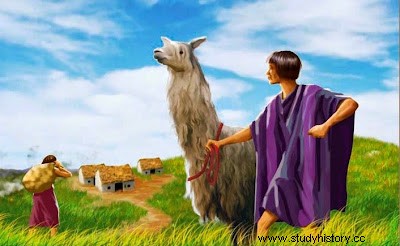 Aymara grazing ECONOMIC ORGANIZATION The Aymara economy was based on livestock and high-altitude crops. In the ranch they raised llamas and alpacas. These camelids provided meat, wool, and manure, as well as being excellent transportation. They cultivated potatoes, quinoa, coca, oca, olluco and cañigua through very ingenious techniques. fertilizer, besides being very ingenious techniques. These techniques were the lakes and ridges or waru waru. The lakes are depressions that accumulate water and rain, the water runs through the furrows irrigating the central area, but avoiding ponding and allowing circulation to the next lake. The lake can be closed and become a pond, which causes a thermal effect on the plants that allows them to survive the cold at night. cultivate them.
Aymara grazing ECONOMIC ORGANIZATION The Aymara economy was based on livestock and high-altitude crops. In the ranch they raised llamas and alpacas. These camelids provided meat, wool, and manure, as well as being excellent transportation. They cultivated potatoes, quinoa, coca, oca, olluco and cañigua through very ingenious techniques. fertilizer, besides being very ingenious techniques. These techniques were the lakes and ridges or waru waru. The lakes are depressions that accumulate water and rain, the water runs through the furrows irrigating the central area, but avoiding ponding and allowing circulation to the next lake. The lake can be closed and become a pond, which causes a thermal effect on the plants that allows them to survive the cold at night. cultivate them.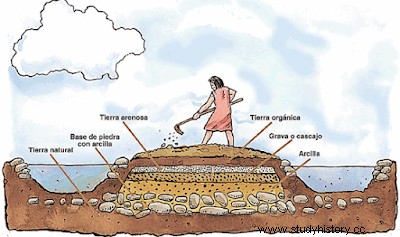
The political economy of these manors more accurately reflects the altiplano tradition of ecological floor control – that comes from Pukara and Tiwanaku– to manage a system of high-altitude agriculture of grasses and tubers, based on qochas and ridges, of grains in the temperate coastal and inter-Andean valleys, and of the use of humid lands in the east. Grazing, textiles and the exchange of goods were actually the basis of the existence of the towns, without neglecting pottery production. High-altitude cattle ranching managed, in particular, the political economy of these manors, and apparently, as Moseley suggests, the intensification of grazing was a response to low agricultural production. These manors colonized land on the southern southern coast, in the east Bolivian (Cochabamba) and in northeastern Argentina. The Lupaqa would have colonized territories as enclaves in Arequipa, Moquegua and eastern Bolivia, as inferred from the study carried out by Lumbreras. Similar events occurred with the Collas, who also occupied coastal and inter-Andean valleys.
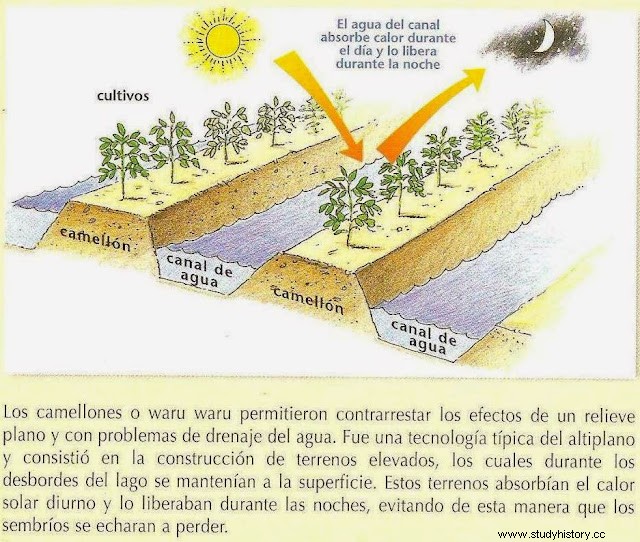
AYMARA SOCIETIES
Gray hair and Canchis The Canas and the Canchis were two Aymara groups that lived outside the Collao plateau, north of the Vilcanota knot, in the headwaters of the Vilcanota rivers and the current province of Espinar. Before the conquest by the Inca Empire, they were allies of the Incas and participated as mercenary soldiers in the invasion of Andahuaylas, supporting the Incas in exchange for spoils of war.
Collas In the case of the Collas, those of Hatuncolla stand out archaeologically, studied intensely by Catherine Julián, describing the main Colla site as their possible capital; in addition to being associated with the Sillustani chullpas complex, located a short distance from Hatuncolla.
Lupacas The lupacas (lupaqa) were an ethnic group that inhabited the Aymara city that inhabited the southwestern shore of Lake Titicaca. They had seven subdivisions that were:Chucuito -the capital-, Ácora, Ilave, Yunguyo, Pomata, Zepita and Juli. Each subdivision in turn was divided into two "saya" (except for Juli who had three "saya"). Each "saya" was made up of several "hatha", which was the Aymara word to designate the "ayllus". On the Pacific Ocean coast adjoining the Collao, they owned land distributed among the valleys of the Moquegua, Locumba, Sama, and Caplina rivers. , Lluta, Azapa and Camarones and the ethnohistorical data also place them in the temperate valleys of Chicanoma and Capinota (both in the region of the inter-Andean valleys of Bolivia) destined mainly for the cultivation of coca crops. On the lands on the Pacific slope, the Lupaqa did not have absolute control over the valleys, but rather discontinuously owned portions of land that the ethnohistorian John Murra called "ecological islands", which were worked by the "hatha" from the Lupaqas population centers in the highlands. and that they had the purpose of producing crops from diverse ecological regions to complement their diet. These valleys of the Pacific coast, in fact, also had "ecological islands" of other Aymara kingdoms of the highlands such as the Collas or the Pacajes (which in the highlands were located to the north and south of the Lupaqas, respectively).
Packages The Pacajes or Pacaza were an Aymara group that inhabited the territory located southeast of Lake Titicaca. Their capital was the city of Caquiaviri and they were divided into two groups called "omasuyu" and "urcusuyu". They extended to the south as far as Sica Sica and Umala, where the territories of the manors "Caranga" and "Sora" began; to the northeast to the Achacachi peninsula, where the Colla territory began, and to the northwest to the source of the Desaguadero River in Titicaca, where the Lupaca territory began. Ethnohistoric records show that they had territories in Calamarca and Larecaja and several coca crops in the yungas. Along the coast, there is archaeological evidence of Pacajes in the basins of the Caplina, Lluta and Azapa rivers. The best preserved Pacajes archaeological remains are several groups of chullpares distributed both in the highlands and in the colonies on lower lands. The Pacajes chullpas were very varied, existing chullpares of clay with colored coating and in other cases stone chullpas with a square, rectangular or circular base. Studies in the "big chullpa of Pirapi Chico" located in Achiri date it to pre-Inca times but it has an Inca construction style, this particularity also occurs in the "Chosi Kani" chullpa of Anantuco and the Jachaphasa Fortress dated between 1323 and 1428, before the Inca conquest in the Pacajes.
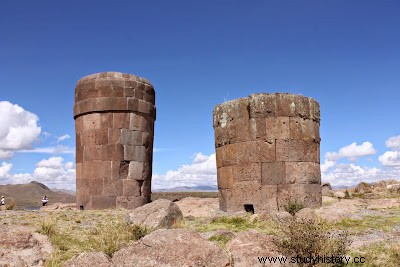 Chullpas POLITICS Duality was a concept present in the organization of space, society and politics. The visit of Garci Diez de San Miguel (1567) speaks of the parallel lupaqa rulers, called Cari and Cusi, who owned thousands of llamas and alpacas, and politically organized their territory into Anansaya and Urinsaya.
Chullpas POLITICS Duality was a concept present in the organization of space, society and politics. The visit of Garci Diez de San Miguel (1567) speaks of the parallel lupaqa rulers, called Cari and Cusi, who owned thousands of llamas and alpacas, and politically organized their territory into Anansaya and Urinsaya.The politics of These kingdoms were organized according to their urban centers near Lake Titicaca such as Chucuito, Acora, Juli, etc. The government of these towns was of two leaders. The Lupaca kings were two known by the names of Cari and Cusi. After the kings came a small group of noblemen.
At the service of this nobility were:
The Mitani forced to work a certain number of days a year. These Mitani ayamra were similar to the Mitayos Incas.
The Yana were servants for life.
The Uros are the ones who were below all other social classes.
Among the Aymara kingdoms, two were the most important:the Collas and the Lupaca. The Collas had Hutun Colla as their capital, and the capital of the Lupaca was Chucuito. Between these two kingdoms there was a permanent rivalry from the beginning of their culture.
COSMOVISION
The Aymara peoples have had different local gods that were based on the agricultural religion and the worship of the dead. The ancient Aymara god is Thunupa, who is the central icon of the sculpture as the gate of sun, wind, rain and hail.
The goddess Pachamama (mother earth) was the producer of food and grasslands, this goddess demands sacrifices.
The local gods are the protective hills such as Auki and Achachilla. The gods of evil were the underground known as Anchanchau or Saxra.
SOURCE:JULIAN Y. SANTILLANA "Wari and Tiawanaco Pan-Andean States". 2000
